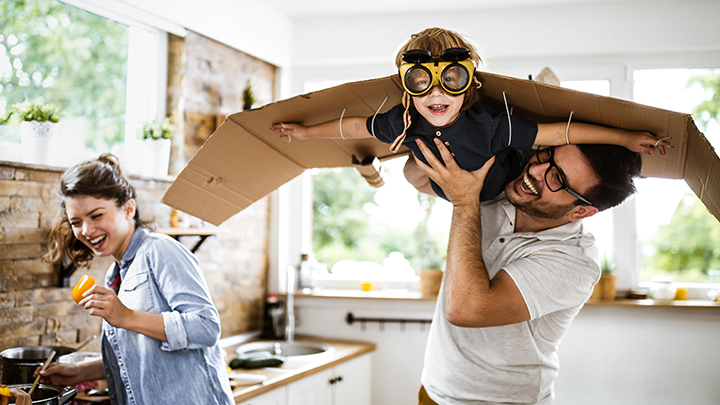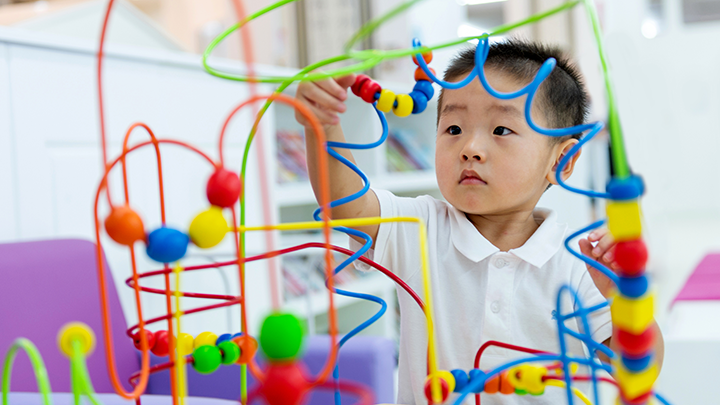
April 8, 2020
Welcome to Healthy Together, your guide to family and home life during COVID-19. Read the archive.

Whether it’s being physically active, creative or imaginative, children need time for play. Every day. And especially when staying at home these days.

Kids need plenty of unstructured play, such as playing with objects or using their imagination to invent brand new games and activities. Wherever your children play, you can watch, wait and listen.
Whatever your age, play can make your day. For your children, play is essential. Especially in this time of physical distancing and staying at home.
Children need lots of playtime. “From ages one to four, children need at least three hours of activity over the course of the day,” says Laura Crawford, a program facilitator with Healthy Children and Families at Alberta Health Services. “Children five and older need at least one hour of moderate to vigorous physical activity every day.”
Some play can be structured and led by you to help your kids learn a new skill or activity. “Structured activities are things such as kicking a ball, throwing a ball or playing soccer in the backyard.”
Kids also need plenty of unstructured play, such as playing with objects or using their imagination to invent brand new games and activities. Crawford suggests letting most play be unstructured.
When outside in these days of flattening the COVID-19 curve, your kids will need even closer supervision. All children need to learn physical distancing and to avoid surfaces others have touched.
Wherever your children play, you can watch, wait and listen. See what they’re interested in and what they may be struggling with. Give them time to practise and figure things out on their own before offering help. Follow your child’s lead. Ask them to describe what they’re doing or if you can join in.
You can play in thousands of different ways with everyday items and simple toys. Toys and equipment have a place: the best ones are those that let you and your child make up stories as you play together. Toys from popular television shows or movies already have a storyline and that may thwart the creative potential of play.
Balls are a blast, Lego is lovely and screens are all around. But no toy, game or virtual pastime is more fascinating and beneficial to a child than playing and interacting with you.
Most of all, play is a great way for families and children alike to relieve stress and strengthen family ties. In other words, play is serious fun.
Play is one of the most important ways your children learn. It helps brains develop and helps build lifelong skills such as problem-solving and positive relationships with others. Through play, children also:
Learn more about play at Healthy Parents, Healthy Children.
Praising and encouraging your children are two different things. Praise typically focuses on the child, while encouragement focuses what the child does. Praise may lose its meaning if used too much. Encouragement helps children develop self-confidence and self-esteem. See more at Healthy Parents, Healthy Children.
Boks Canada
This Canadian organization is dedicated to bringing physical activities to schools. It’s repurposed many activities into a suite of downloadable fun packs for the COVID-19 crisis, including Boks Bursts: Get Kids Moving & Having Fun at Home. Sign up for free download. Also see Boks Bursts on YouTube.
Playful Advice
To Do Canada has posted 25 Fun Things to Do with Kids Inside Your Home. Their tips include classics such as dressing up, building a fort and making a masterpiece.
Hide & Seek
This timeless game is for kids of all ages — including parents. It helps kids practise counting, problem-solve (what’s the best hiding place) and interact with others. A game can go on for hours. If space is tight for hiding people at your home, you can switch up the game and hide a teddy bear. The thrill of finding someone or something never gets old.
Match ’em Up
Make laundry fun! Throw an armful of socks on a clean floor or table and sort as fast as you can. Make it competitive by seeing who can sort and fold the most socks. This is one in a series of Active8 Your Home daily videos from Recess Guardians, a Saskatchewan program that promotes active play in schools across the province. Also try: Flag Tag, Gone Fishin’ and Land, Sea, Air.
Stacking
The Calgary Public Library recommends this sensory activity. Use wooden or plastic blocks, plastic cups, or any toddler-friendly object that they can stack. As your child stacks the pieces, they discover shapes, learning how blocks can be balanced, watching how they fall and discovering what fits together. Your child can do this alone or with you.
Indoor Camping
Push the furniture back and put up a pop-up tent in the living room. No tent? Hang a sheet between a couple of chairs. Gather round a small lamp or flashlight and share stories about past trips. Or read a book together. Make a night of it with sleeping bags and pillows.
Teddy Bear Activity Kit
Book publisher Penguin Random House offers several free and downloadable activity kits, including The Teddy Bear of the Year Activity Kit. Even if you don’t have the book the activities are based on (The Teddy Bear of the Year), you can enjoy the kit’s ideas and resources.
Play & Learn
This website includes games and activities suitable for three age groups: toddler (18 to 30 months); preschool (over 30 months to 4 years); and kindergarten (over 4 years to 6 years). All games and activities help build your children’s thinking and learning, social and emotional, movement and language skills.
Zero to Three
Zero to Three is filled with insight about the first three years of children’s development. Its new At-Home Activity Guide offers great practical tips about spending days with your little ones. This short excerpt shows how easy it can be to make play part of your day:
Physical Play: Little ones need to move and work their bodies…and voices. They will need opportunities to be loud, run, climb, and jump . . . Here are some ideas:
Get Kids Moving
Healthy Kids, Healthy Futures builds on the work of former American First Lady Michelle Obama’s Let’s Move initiative. You’ll find dozens of activities and supporting resources for children and families, including activity sheets, detailed instructions and downloadable music.
If you’d like to share your stories and pictures of play and family activities, drop us a line at healthy.together@ahs.ca.
Related Feature: Parents Take Care of Yourselves